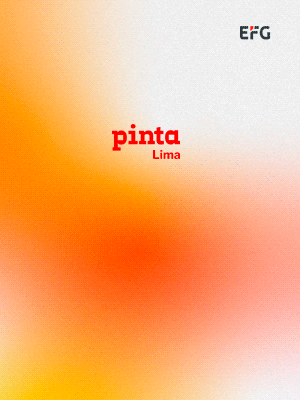THE SUBTLE EMBROIDERY OF PAIN BY MARISA CAICHIOLO AT LNM MUSEUM
The Museo La Neomudéjar presents No hay más ciego que el que no quiere ver (No one is more blind than the one who refuses to see), a solo exhibition by Marisa Caichiolo (Santa Fe, Argentina, 1974). In this project, the artist explores and materializes pain and absence, primarily through embroidery. Drawing from her personal experiences, Caichiolo constructs narratives of resistance and instrumental memory to confront traumatic episodes—many of them rooted in forced disappearances.
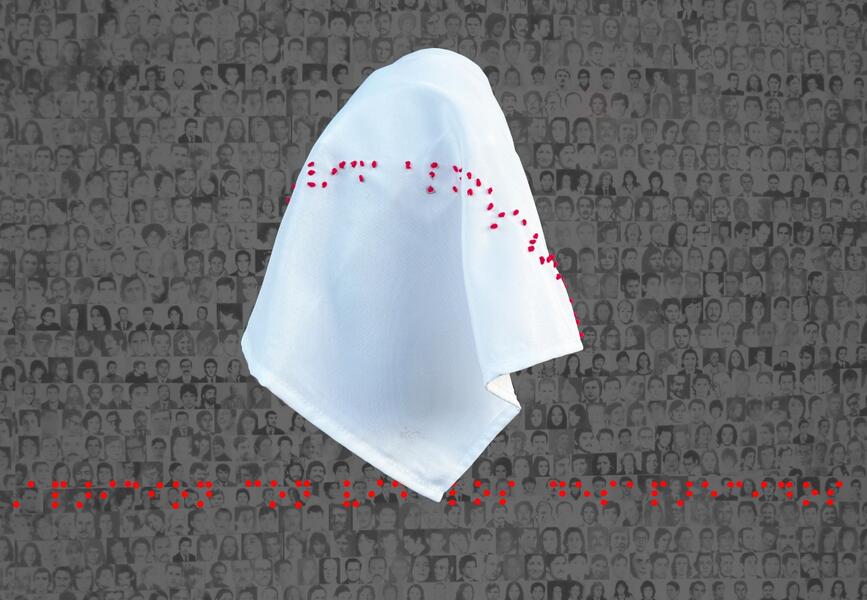
Embroidery, a technique she has frequently used in recent years, becomes a powerful medium for expressing a message that is not only aesthetic or artistic but also deeply political. Rather than isolating these elements, she integrates them with objects and video art, expanding the scope of her analysis beyond the material realm.
Her work also underscores the importance of recognizing and studying historical records, acknowledging the weight of memory. Without ignoring the emotional impact of these events, Caichiolo creates experiences that evoke the home, the intimate and shared space, and the bonds of family. Through subtlety and restraint, she reinforces the urgency of resistance against the passage of time and the unfolding of history.
No hay más ciego que el que no quiere ver can be seen until April 16 at Museo Centro de Artes de Vanguardia La Neomudéjar, Antonio Nebrija, s/n, Madrid (Spain).
Related Topics
May interest you
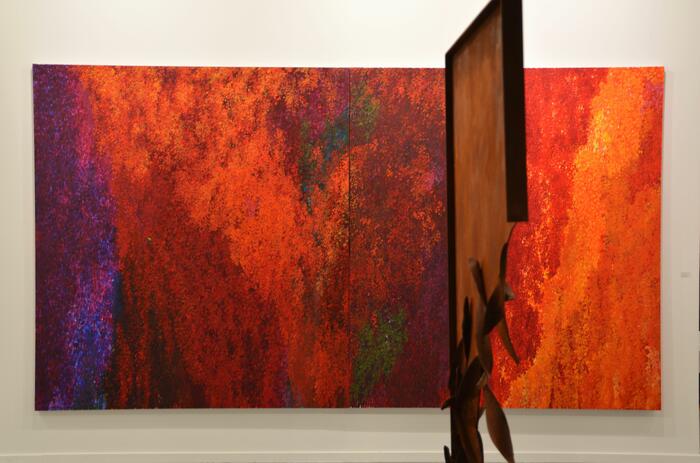
ARCOmadrid 2025 comes to an end with almost as many answers as questions. On the one hand, the concept of the fair—its commercial dimension—is now firmly established, marking a shift from the situation of a few years ago, when ARCO’s role as a meeting point for the general public seemed essential. This does not mean that attracting an audience with access to contemporary art is no longer part of its strategy, but rather that the fair now operates with a dual focus on two clearly defined lines of work: what and how. This shift consolidates the growing emphasis on collectors and institutions.
A CRITICAL OVERVIEW AT ARCO 2025
ARCOmadrid 2025 comes to an end with almost as many answers as questions. On the one hand, the concept of the fair—its commercial dimension—is now firmly established, marking a shift from the situation of a few years ago, when ARCO’s role as a meeting point for the general public seemed essential. This does not mean that attracting an audience with access to contemporary art is no longer part of its strategy, but rather that the fair now operates with a dual focus on two clearly defined lines of work: what and how. This shift consolidates the growing emphasis on collectors and institutions.

ARCOmadrid 2025 comes to an end with almost as many answers as questions. On the one hand, the concept of the fair—its commercial dimension—is now firmly established, marking a shift from the situation of a few years ago, when ARCO’s role as a meeting point for the general public seemed essential. This does not mean that attracting an audience with access to contemporary art is no longer part of its strategy, but rather that the fair now operates with a dual focus on two clearly defined lines of work: what and how. This shift consolidates the growing emphasis on collectors and institutions.
A CRITICAL OVERVIEW AT ARCO 2025
ARCOmadrid 2025 comes to an end with almost as many answers as questions. On the one hand, the concept of the fair—its commercial dimension—is now firmly established, marking a shift from the situation of a few years ago, when ARCO’s role as a meeting point for the general public seemed essential. This does not mean that attracting an audience with access to contemporary art is no longer part of its strategy, but rather that the fair now operates with a dual focus on two clearly defined lines of work: what and how. This shift consolidates the growing emphasis on collectors and institutions.
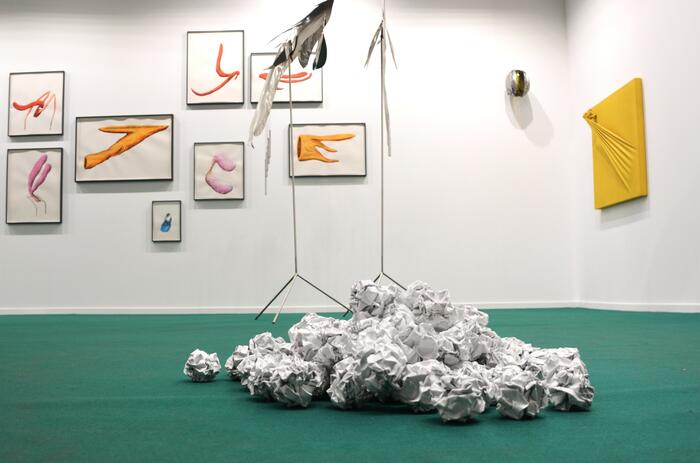
With strong gallery participation, ARCO is an interesting point to measure how the proposals reach the visitor and the collector. The choices based on aesthetic or commercial criteria create synergies that shape a fluid and sometimes circumstantial representation of each catalog. From Arte al Día, we delve into ten of those catalogs, expanded to variegated universes, monographs and dialogues that show a sample of the approach of Latin American galleries in their presence at the Madrid fair.
THE UNIVERSES OF THE LATIN AMERICAN GALLERIES IN ARCO
With strong gallery participation, ARCO is an interesting point to measure how the proposals reach the visitor and the collector. The choices based on aesthetic or commercial criteria create synergies that shape a fluid and sometimes circumstantial representation of each catalog. From Arte al Día, we delve into ten of those catalogs, expanded to variegated universes, monographs and dialogues that show a sample of the approach of Latin American galleries in their presence at the Madrid fair.
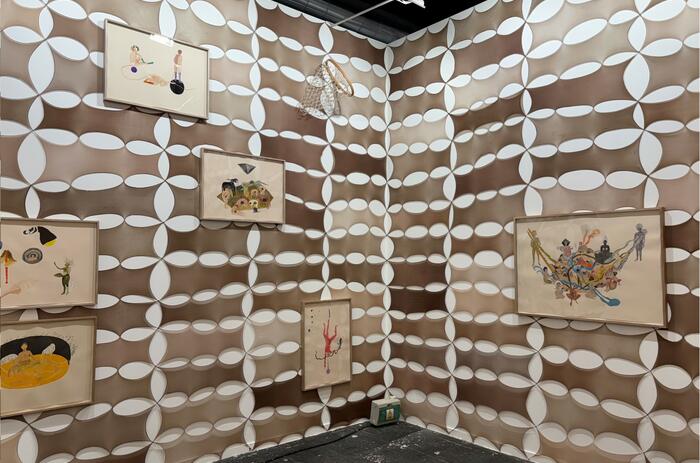
The Museo Nacional Centro de Arte Reina Sofía has announced the acquisitions made during the ARCO fair, through which both the institution and the Ministry of Culture expand the museum’s collections. Among the artists whose work is now part of the Madrid-based institution are Argentine artist Marta Minujín and Colombian artists Juan Pablo Echeverri and Luz Lizarazo—three figures with different career trajectories who bring a distinct Latin American perspective to a list of acquisitions largely focused on Spanish artists.
THE REINA SOFÍA ACQUIRES WORKS BY MINUJÍN, LIZARAZO AND ECHEVERRI AT ARCO FOR ITS COLLECTION
The Museo Nacional Centro de Arte Reina Sofía has announced the acquisitions made during the ARCO fair, through which both the institution and the Ministry of Culture expand the museum’s collections. Among the artists whose work is now part of the Madrid-based institution are Argentine artist Marta Minujín and Colombian artists Juan Pablo Echeverri and Luz Lizarazo—three figures with different career trajectories who bring a distinct Latin American perspective to a list of acquisitions largely focused on Spanish artists.
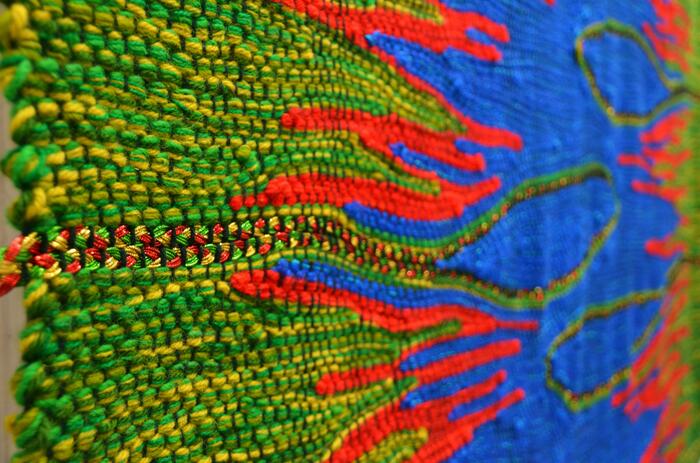
The Latin American presence at ARCO is consolidating year after year, establishing itself as a primary guiding thread beyond market trends, becoming a significant part of the identity of the Madrid fair. In this sense, the participating galleries in the various programs showcase well-established names as well as younger or more radical bets, shaping an ecosystem in which various productions can be analyzed.
ARCO 2025: DIFFERENT VIEWS ON LATIN AMERICA
The Latin American presence at ARCO is consolidating year after year, establishing itself as a primary guiding thread beyond market trends, becoming a significant part of the identity of the Madrid fair. In this sense, the participating galleries in the various programs showcase well-established names as well as younger or more radical bets, shaping an ecosystem in which various productions can be analyzed.
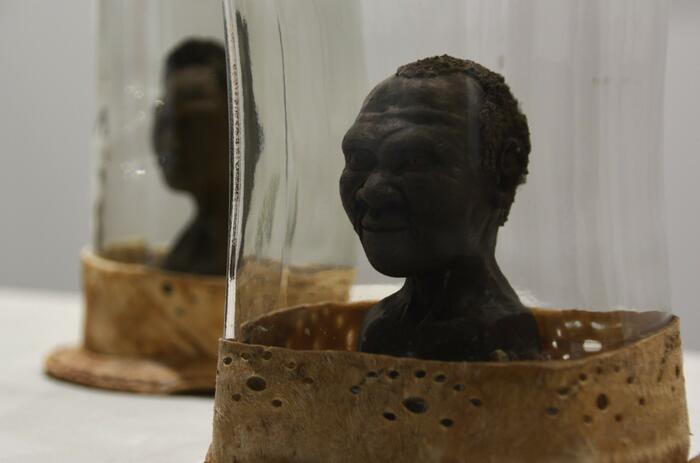
The organization has entrusted Mexican curator José Esparza Chong Cuy with the development of Perfiles | Arte latinoamericano, a curated journey that highlights, through ten selected figures, the diversity of visual approaches. As the curator himself states, it offers "a broad panorama of how to identify as artists and build community, proposing new ways of making, thinking, and living together."
THE LATIN AMERICAN GAZE IN ARCO’S “PROFILES” PROGRAM
The organization has entrusted Mexican curator José Esparza Chong Cuy with the development of Perfiles | Arte latinoamericano, a curated journey that highlights, through ten selected figures, the diversity of visual approaches. As the curator himself states, it offers "a broad panorama of how to identify as artists and build community, proposing new ways of making, thinking, and living together."
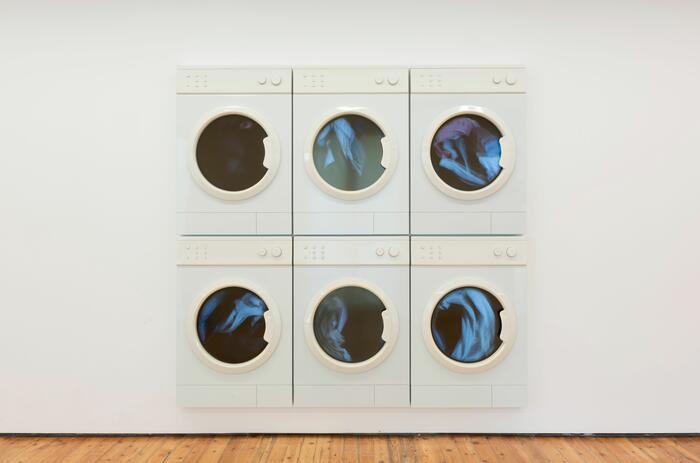
La nevera en la sala (The Fridge in the Living Room) is the arrangement through which Leandro Erlich (Buenos Aires, Argentina, 1973) reinterprets his vision of perception through architecture and everyday life at Prats Nogueras Blanchard. A recurring theme in this Argentine artist’s work, the pieces exhibited at the gallery’s Madrid headquarters do not belong to a new production but rather mark the first public presentation of a series of works that engage with realism and illusion, complemented by their location and functionality within the space.
PERCEPTION AND QUOTIDIANITY IN LEANDRO ERLICH
La nevera en la sala (The Fridge in the Living Room) is the arrangement through which Leandro Erlich (Buenos Aires, Argentina, 1973) reinterprets his vision of perception through architecture and everyday life at Prats Nogueras Blanchard. A recurring theme in this Argentine artist’s work, the pieces exhibited at the gallery’s Madrid headquarters do not belong to a new production but rather mark the first public presentation of a series of works that engage with realism and illusion, complemented by their location and functionality within the space.
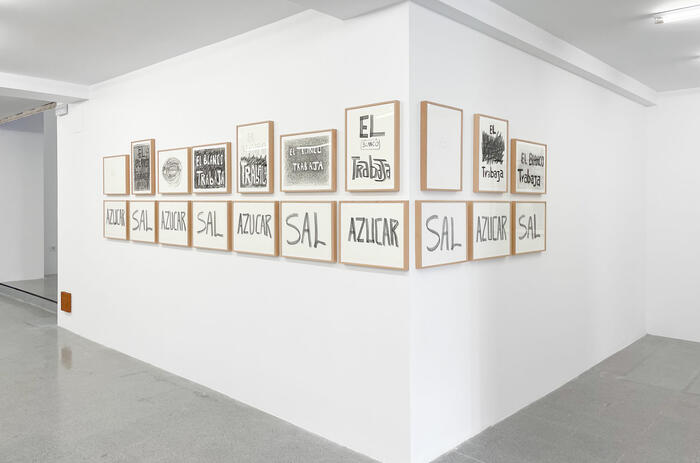
The concern about how the surrounding affects not only the individual but also artistic production connects with the principle by which Édgar Calel (San Juan Comalapa, Guatemala, 1987) has developed a unique project from scratch at La Oficina gallery. Sueños guardados en granos de maíz brings us to a specific moment of materialization, but it expands toward all the vertices with which the artist works, delving above all into the importance of ancestry, identity, and the spirituality that is related to space.
TRADITION, IDENTITY AND CONTEMPORARY LANGUAGE IN ÉDGAR CALEL
The concern about how the surrounding affects not only the individual but also artistic production connects with the principle by which Édgar Calel (San Juan Comalapa, Guatemala, 1987) has developed a unique project from scratch at La Oficina gallery. Sueños guardados en granos de maíz brings us to a specific moment of materialization, but it expands toward all the vertices with which the artist works, delving above all into the importance of ancestry, identity, and the spirituality that is related to space.

The Casa Nacional del Bicentenario has inaugurated Una Casa. La Casa. Lo doméstico deviene territorios (A House. The House. The Domestic Becomes Territories). This is the first public exhibition of works from the collection of Abel Guaglianone and Joaquín Rodríguez.
AN EXHIBITION OF 200 PIECES OF ARGENTINE ART
The Casa Nacional del Bicentenario has inaugurated Una Casa. La Casa. Lo doméstico deviene territorios (A House. The House. The Domestic Becomes Territories). This is the first public exhibition of works from the collection of Abel Guaglianone and Joaquín Rodríguez.

ARCOmadrid 2025 comes to an end with almost as many answers as questions. On the one hand, the concept of the fair—its commercial dimension—is now firmly established, marking a shift from the situation of a few years ago, when ARCO’s role as a meeting point for the general public seemed essential. This does not mean that attracting an audience with access to contemporary art is no longer part of its strategy, but rather that the fair now operates with a dual focus on two clearly defined lines of work: what and how. This shift consolidates the growing emphasis on collectors and institutions.
A CRITICAL OVERVIEW AT ARCO 2025
ARCOmadrid 2025 comes to an end with almost as many answers as questions. On the one hand, the concept of the fair—its commercial dimension—is now firmly established, marking a shift from the situation of a few years ago, when ARCO’s role as a meeting point for the general public seemed essential. This does not mean that attracting an audience with access to contemporary art is no longer part of its strategy, but rather that the fair now operates with a dual focus on two clearly defined lines of work: what and how. This shift consolidates the growing emphasis on collectors and institutions.

With strong gallery participation, ARCO is an interesting point to measure how the proposals reach the visitor and the collector. The choices based on aesthetic or commercial criteria create synergies that shape a fluid and sometimes circumstantial representation of each catalog. From Arte al Día, we delve into ten of those catalogs, expanded to variegated universes, monographs and dialogues that show a sample of the approach of Latin American galleries in their presence at the Madrid fair.
THE UNIVERSES OF THE LATIN AMERICAN GALLERIES IN ARCO
With strong gallery participation, ARCO is an interesting point to measure how the proposals reach the visitor and the collector. The choices based on aesthetic or commercial criteria create synergies that shape a fluid and sometimes circumstantial representation of each catalog. From Arte al Día, we delve into ten of those catalogs, expanded to variegated universes, monographs and dialogues that show a sample of the approach of Latin American galleries in their presence at the Madrid fair.

The Museo Nacional Centro de Arte Reina Sofía has announced the acquisitions made during the ARCO fair, through which both the institution and the Ministry of Culture expand the museum’s collections. Among the artists whose work is now part of the Madrid-based institution are Argentine artist Marta Minujín and Colombian artists Juan Pablo Echeverri and Luz Lizarazo—three figures with different career trajectories who bring a distinct Latin American perspective to a list of acquisitions largely focused on Spanish artists.
THE REINA SOFÍA ACQUIRES WORKS BY MINUJÍN, LIZARAZO AND ECHEVERRI AT ARCO FOR ITS COLLECTION
The Museo Nacional Centro de Arte Reina Sofía has announced the acquisitions made during the ARCO fair, through which both the institution and the Ministry of Culture expand the museum’s collections. Among the artists whose work is now part of the Madrid-based institution are Argentine artist Marta Minujín and Colombian artists Juan Pablo Echeverri and Luz Lizarazo—three figures with different career trajectories who bring a distinct Latin American perspective to a list of acquisitions largely focused on Spanish artists.

The Latin American presence at ARCO is consolidating year after year, establishing itself as a primary guiding thread beyond market trends, becoming a significant part of the identity of the Madrid fair. In this sense, the participating galleries in the various programs showcase well-established names as well as younger or more radical bets, shaping an ecosystem in which various productions can be analyzed.
ARCO 2025: DIFFERENT VIEWS ON LATIN AMERICA
The Latin American presence at ARCO is consolidating year after year, establishing itself as a primary guiding thread beyond market trends, becoming a significant part of the identity of the Madrid fair. In this sense, the participating galleries in the various programs showcase well-established names as well as younger or more radical bets, shaping an ecosystem in which various productions can be analyzed.

The organization has entrusted Mexican curator José Esparza Chong Cuy with the development of Perfiles | Arte latinoamericano, a curated journey that highlights, through ten selected figures, the diversity of visual approaches. As the curator himself states, it offers "a broad panorama of how to identify as artists and build community, proposing new ways of making, thinking, and living together."
THE LATIN AMERICAN GAZE IN ARCO’S “PROFILES” PROGRAM
The organization has entrusted Mexican curator José Esparza Chong Cuy with the development of Perfiles | Arte latinoamericano, a curated journey that highlights, through ten selected figures, the diversity of visual approaches. As the curator himself states, it offers "a broad panorama of how to identify as artists and build community, proposing new ways of making, thinking, and living together."

La nevera en la sala (The Fridge in the Living Room) is the arrangement through which Leandro Erlich (Buenos Aires, Argentina, 1973) reinterprets his vision of perception through architecture and everyday life at Prats Nogueras Blanchard. A recurring theme in this Argentine artist’s work, the pieces exhibited at the gallery’s Madrid headquarters do not belong to a new production but rather mark the first public presentation of a series of works that engage with realism and illusion, complemented by their location and functionality within the space.
PERCEPTION AND QUOTIDIANITY IN LEANDRO ERLICH
La nevera en la sala (The Fridge in the Living Room) is the arrangement through which Leandro Erlich (Buenos Aires, Argentina, 1973) reinterprets his vision of perception through architecture and everyday life at Prats Nogueras Blanchard. A recurring theme in this Argentine artist’s work, the pieces exhibited at the gallery’s Madrid headquarters do not belong to a new production but rather mark the first public presentation of a series of works that engage with realism and illusion, complemented by their location and functionality within the space.

The concern about how the surrounding affects not only the individual but also artistic production connects with the principle by which Édgar Calel (San Juan Comalapa, Guatemala, 1987) has developed a unique project from scratch at La Oficina gallery. Sueños guardados en granos de maíz brings us to a specific moment of materialization, but it expands toward all the vertices with which the artist works, delving above all into the importance of ancestry, identity, and the spirituality that is related to space.
TRADITION, IDENTITY AND CONTEMPORARY LANGUAGE IN ÉDGAR CALEL
The concern about how the surrounding affects not only the individual but also artistic production connects with the principle by which Édgar Calel (San Juan Comalapa, Guatemala, 1987) has developed a unique project from scratch at La Oficina gallery. Sueños guardados en granos de maíz brings us to a specific moment of materialization, but it expands toward all the vertices with which the artist works, delving above all into the importance of ancestry, identity, and the spirituality that is related to space.

The Casa Nacional del Bicentenario has inaugurated Una Casa. La Casa. Lo doméstico deviene territorios (A House. The House. The Domestic Becomes Territories). This is the first public exhibition of works from the collection of Abel Guaglianone and Joaquín Rodríguez.
AN EXHIBITION OF 200 PIECES OF ARGENTINE ART
The Casa Nacional del Bicentenario has inaugurated Una Casa. La Casa. Lo doméstico deviene territorios (A House. The House. The Domestic Becomes Territories). This is the first public exhibition of works from the collection of Abel Guaglianone and Joaquín Rodríguez.

ARCOmadrid 2025 comes to an end with almost as many answers as questions. On the one hand, the concept of the fair—its commercial dimension—is now firmly established, marking a shift from the situation of a few years ago, when ARCO’s role as a meeting point for the general public seemed essential. This does not mean that attracting an audience with access to contemporary art is no longer part of its strategy, but rather that the fair now operates with a dual focus on two clearly defined lines of work: what and how. This shift consolidates the growing emphasis on collectors and institutions.
A CRITICAL OVERVIEW AT ARCO 2025
ARCOmadrid 2025 comes to an end with almost as many answers as questions. On the one hand, the concept of the fair—its commercial dimension—is now firmly established, marking a shift from the situation of a few years ago, when ARCO’s role as a meeting point for the general public seemed essential. This does not mean that attracting an audience with access to contemporary art is no longer part of its strategy, but rather that the fair now operates with a dual focus on two clearly defined lines of work: what and how. This shift consolidates the growing emphasis on collectors and institutions.

With strong gallery participation, ARCO is an interesting point to measure how the proposals reach the visitor and the collector. The choices based on aesthetic or commercial criteria create synergies that shape a fluid and sometimes circumstantial representation of each catalog. From Arte al Día, we delve into ten of those catalogs, expanded to variegated universes, monographs and dialogues that show a sample of the approach of Latin American galleries in their presence at the Madrid fair.
THE UNIVERSES OF THE LATIN AMERICAN GALLERIES IN ARCO
With strong gallery participation, ARCO is an interesting point to measure how the proposals reach the visitor and the collector. The choices based on aesthetic or commercial criteria create synergies that shape a fluid and sometimes circumstantial representation of each catalog. From Arte al Día, we delve into ten of those catalogs, expanded to variegated universes, monographs and dialogues that show a sample of the approach of Latin American galleries in their presence at the Madrid fair.

The Museo Nacional Centro de Arte Reina Sofía has announced the acquisitions made during the ARCO fair, through which both the institution and the Ministry of Culture expand the museum’s collections. Among the artists whose work is now part of the Madrid-based institution are Argentine artist Marta Minujín and Colombian artists Juan Pablo Echeverri and Luz Lizarazo—three figures with different career trajectories who bring a distinct Latin American perspective to a list of acquisitions largely focused on Spanish artists.
THE REINA SOFÍA ACQUIRES WORKS BY MINUJÍN, LIZARAZO AND ECHEVERRI AT ARCO FOR ITS COLLECTION
The Museo Nacional Centro de Arte Reina Sofía has announced the acquisitions made during the ARCO fair, through which both the institution and the Ministry of Culture expand the museum’s collections. Among the artists whose work is now part of the Madrid-based institution are Argentine artist Marta Minujín and Colombian artists Juan Pablo Echeverri and Luz Lizarazo—three figures with different career trajectories who bring a distinct Latin American perspective to a list of acquisitions largely focused on Spanish artists.

The Latin American presence at ARCO is consolidating year after year, establishing itself as a primary guiding thread beyond market trends, becoming a significant part of the identity of the Madrid fair. In this sense, the participating galleries in the various programs showcase well-established names as well as younger or more radical bets, shaping an ecosystem in which various productions can be analyzed.
ARCO 2025: DIFFERENT VIEWS ON LATIN AMERICA
The Latin American presence at ARCO is consolidating year after year, establishing itself as a primary guiding thread beyond market trends, becoming a significant part of the identity of the Madrid fair. In this sense, the participating galleries in the various programs showcase well-established names as well as younger or more radical bets, shaping an ecosystem in which various productions can be analyzed.

The organization has entrusted Mexican curator José Esparza Chong Cuy with the development of Perfiles | Arte latinoamericano, a curated journey that highlights, through ten selected figures, the diversity of visual approaches. As the curator himself states, it offers "a broad panorama of how to identify as artists and build community, proposing new ways of making, thinking, and living together."
THE LATIN AMERICAN GAZE IN ARCO’S “PROFILES” PROGRAM
The organization has entrusted Mexican curator José Esparza Chong Cuy with the development of Perfiles | Arte latinoamericano, a curated journey that highlights, through ten selected figures, the diversity of visual approaches. As the curator himself states, it offers "a broad panorama of how to identify as artists and build community, proposing new ways of making, thinking, and living together."

La nevera en la sala (The Fridge in the Living Room) is the arrangement through which Leandro Erlich (Buenos Aires, Argentina, 1973) reinterprets his vision of perception through architecture and everyday life at Prats Nogueras Blanchard. A recurring theme in this Argentine artist’s work, the pieces exhibited at the gallery’s Madrid headquarters do not belong to a new production but rather mark the first public presentation of a series of works that engage with realism and illusion, complemented by their location and functionality within the space.
PERCEPTION AND QUOTIDIANITY IN LEANDRO ERLICH
La nevera en la sala (The Fridge in the Living Room) is the arrangement through which Leandro Erlich (Buenos Aires, Argentina, 1973) reinterprets his vision of perception through architecture and everyday life at Prats Nogueras Blanchard. A recurring theme in this Argentine artist’s work, the pieces exhibited at the gallery’s Madrid headquarters do not belong to a new production but rather mark the first public presentation of a series of works that engage with realism and illusion, complemented by their location and functionality within the space.

The concern about how the surrounding affects not only the individual but also artistic production connects with the principle by which Édgar Calel (San Juan Comalapa, Guatemala, 1987) has developed a unique project from scratch at La Oficina gallery. Sueños guardados en granos de maíz brings us to a specific moment of materialization, but it expands toward all the vertices with which the artist works, delving above all into the importance of ancestry, identity, and the spirituality that is related to space.
TRADITION, IDENTITY AND CONTEMPORARY LANGUAGE IN ÉDGAR CALEL
The concern about how the surrounding affects not only the individual but also artistic production connects with the principle by which Édgar Calel (San Juan Comalapa, Guatemala, 1987) has developed a unique project from scratch at La Oficina gallery. Sueños guardados en granos de maíz brings us to a specific moment of materialization, but it expands toward all the vertices with which the artist works, delving above all into the importance of ancestry, identity, and the spirituality that is related to space.

The Casa Nacional del Bicentenario has inaugurated Una Casa. La Casa. Lo doméstico deviene territorios (A House. The House. The Domestic Becomes Territories). This is the first public exhibition of works from the collection of Abel Guaglianone and Joaquín Rodríguez.
AN EXHIBITION OF 200 PIECES OF ARGENTINE ART
The Casa Nacional del Bicentenario has inaugurated Una Casa. La Casa. Lo doméstico deviene territorios (A House. The House. The Domestic Becomes Territories). This is the first public exhibition of works from the collection of Abel Guaglianone and Joaquín Rodríguez.

ARCOmadrid 2025 comes to an end with almost as many answers as questions. On the one hand, the concept of the fair—its commercial dimension—is now firmly established, marking a shift from the situation of a few years ago, when ARCO’s role as a meeting point for the general public seemed essential. This does not mean that attracting an audience with access to contemporary art is no longer part of its strategy, but rather that the fair now operates with a dual focus on two clearly defined lines of work: what and how. This shift consolidates the growing emphasis on collectors and institutions.
A CRITICAL OVERVIEW AT ARCO 2025
ARCOmadrid 2025 comes to an end with almost as many answers as questions. On the one hand, the concept of the fair—its commercial dimension—is now firmly established, marking a shift from the situation of a few years ago, when ARCO’s role as a meeting point for the general public seemed essential. This does not mean that attracting an audience with access to contemporary art is no longer part of its strategy, but rather that the fair now operates with a dual focus on two clearly defined lines of work: what and how. This shift consolidates the growing emphasis on collectors and institutions.

With strong gallery participation, ARCO is an interesting point to measure how the proposals reach the visitor and the collector. The choices based on aesthetic or commercial criteria create synergies that shape a fluid and sometimes circumstantial representation of each catalog. From Arte al Día, we delve into ten of those catalogs, expanded to variegated universes, monographs and dialogues that show a sample of the approach of Latin American galleries in their presence at the Madrid fair.
THE UNIVERSES OF THE LATIN AMERICAN GALLERIES IN ARCO
With strong gallery participation, ARCO is an interesting point to measure how the proposals reach the visitor and the collector. The choices based on aesthetic or commercial criteria create synergies that shape a fluid and sometimes circumstantial representation of each catalog. From Arte al Día, we delve into ten of those catalogs, expanded to variegated universes, monographs and dialogues that show a sample of the approach of Latin American galleries in their presence at the Madrid fair.

The Museo Nacional Centro de Arte Reina Sofía has announced the acquisitions made during the ARCO fair, through which both the institution and the Ministry of Culture expand the museum’s collections. Among the artists whose work is now part of the Madrid-based institution are Argentine artist Marta Minujín and Colombian artists Juan Pablo Echeverri and Luz Lizarazo—three figures with different career trajectories who bring a distinct Latin American perspective to a list of acquisitions largely focused on Spanish artists.
THE REINA SOFÍA ACQUIRES WORKS BY MINUJÍN, LIZARAZO AND ECHEVERRI AT ARCO FOR ITS COLLECTION
The Museo Nacional Centro de Arte Reina Sofía has announced the acquisitions made during the ARCO fair, through which both the institution and the Ministry of Culture expand the museum’s collections. Among the artists whose work is now part of the Madrid-based institution are Argentine artist Marta Minujín and Colombian artists Juan Pablo Echeverri and Luz Lizarazo—three figures with different career trajectories who bring a distinct Latin American perspective to a list of acquisitions largely focused on Spanish artists.

The Latin American presence at ARCO is consolidating year after year, establishing itself as a primary guiding thread beyond market trends, becoming a significant part of the identity of the Madrid fair. In this sense, the participating galleries in the various programs showcase well-established names as well as younger or more radical bets, shaping an ecosystem in which various productions can be analyzed.
ARCO 2025: DIFFERENT VIEWS ON LATIN AMERICA
The Latin American presence at ARCO is consolidating year after year, establishing itself as a primary guiding thread beyond market trends, becoming a significant part of the identity of the Madrid fair. In this sense, the participating galleries in the various programs showcase well-established names as well as younger or more radical bets, shaping an ecosystem in which various productions can be analyzed.

The organization has entrusted Mexican curator José Esparza Chong Cuy with the development of Perfiles | Arte latinoamericano, a curated journey that highlights, through ten selected figures, the diversity of visual approaches. As the curator himself states, it offers "a broad panorama of how to identify as artists and build community, proposing new ways of making, thinking, and living together."
THE LATIN AMERICAN GAZE IN ARCO’S “PROFILES” PROGRAM
The organization has entrusted Mexican curator José Esparza Chong Cuy with the development of Perfiles | Arte latinoamericano, a curated journey that highlights, through ten selected figures, the diversity of visual approaches. As the curator himself states, it offers "a broad panorama of how to identify as artists and build community, proposing new ways of making, thinking, and living together."

La nevera en la sala (The Fridge in the Living Room) is the arrangement through which Leandro Erlich (Buenos Aires, Argentina, 1973) reinterprets his vision of perception through architecture and everyday life at Prats Nogueras Blanchard. A recurring theme in this Argentine artist’s work, the pieces exhibited at the gallery’s Madrid headquarters do not belong to a new production but rather mark the first public presentation of a series of works that engage with realism and illusion, complemented by their location and functionality within the space.
PERCEPTION AND QUOTIDIANITY IN LEANDRO ERLICH
La nevera en la sala (The Fridge in the Living Room) is the arrangement through which Leandro Erlich (Buenos Aires, Argentina, 1973) reinterprets his vision of perception through architecture and everyday life at Prats Nogueras Blanchard. A recurring theme in this Argentine artist’s work, the pieces exhibited at the gallery’s Madrid headquarters do not belong to a new production but rather mark the first public presentation of a series of works that engage with realism and illusion, complemented by their location and functionality within the space.

The concern about how the surrounding affects not only the individual but also artistic production connects with the principle by which Édgar Calel (San Juan Comalapa, Guatemala, 1987) has developed a unique project from scratch at La Oficina gallery. Sueños guardados en granos de maíz brings us to a specific moment of materialization, but it expands toward all the vertices with which the artist works, delving above all into the importance of ancestry, identity, and the spirituality that is related to space.
TRADITION, IDENTITY AND CONTEMPORARY LANGUAGE IN ÉDGAR CALEL
The concern about how the surrounding affects not only the individual but also artistic production connects with the principle by which Édgar Calel (San Juan Comalapa, Guatemala, 1987) has developed a unique project from scratch at La Oficina gallery. Sueños guardados en granos de maíz brings us to a specific moment of materialization, but it expands toward all the vertices with which the artist works, delving above all into the importance of ancestry, identity, and the spirituality that is related to space.

The Casa Nacional del Bicentenario has inaugurated Una Casa. La Casa. Lo doméstico deviene territorios (A House. The House. The Domestic Becomes Territories). This is the first public exhibition of works from the collection of Abel Guaglianone and Joaquín Rodríguez.
AN EXHIBITION OF 200 PIECES OF ARGENTINE ART
The Casa Nacional del Bicentenario has inaugurated Una Casa. La Casa. Lo doméstico deviene territorios (A House. The House. The Domestic Becomes Territories). This is the first public exhibition of works from the collection of Abel Guaglianone and Joaquín Rodríguez.

ARCOmadrid 2025 comes to an end with almost as many answers as questions. On the one hand, the concept of the fair—its commercial dimension—is now firmly established, marking a shift from the situation of a few years ago, when ARCO’s role as a meeting point for the general public seemed essential. This does not mean that attracting an audience with access to contemporary art is no longer part of its strategy, but rather that the fair now operates with a dual focus on two clearly defined lines of work: what and how. This shift consolidates the growing emphasis on collectors and institutions.
A CRITICAL OVERVIEW AT ARCO 2025
ARCOmadrid 2025 comes to an end with almost as many answers as questions. On the one hand, the concept of the fair—its commercial dimension—is now firmly established, marking a shift from the situation of a few years ago, when ARCO’s role as a meeting point for the general public seemed essential. This does not mean that attracting an audience with access to contemporary art is no longer part of its strategy, but rather that the fair now operates with a dual focus on two clearly defined lines of work: what and how. This shift consolidates the growing emphasis on collectors and institutions.

With strong gallery participation, ARCO is an interesting point to measure how the proposals reach the visitor and the collector. The choices based on aesthetic or commercial criteria create synergies that shape a fluid and sometimes circumstantial representation of each catalog. From Arte al Día, we delve into ten of those catalogs, expanded to variegated universes, monographs and dialogues that show a sample of the approach of Latin American galleries in their presence at the Madrid fair.
THE UNIVERSES OF THE LATIN AMERICAN GALLERIES IN ARCO
With strong gallery participation, ARCO is an interesting point to measure how the proposals reach the visitor and the collector. The choices based on aesthetic or commercial criteria create synergies that shape a fluid and sometimes circumstantial representation of each catalog. From Arte al Día, we delve into ten of those catalogs, expanded to variegated universes, monographs and dialogues that show a sample of the approach of Latin American galleries in their presence at the Madrid fair.

The Museo Nacional Centro de Arte Reina Sofía has announced the acquisitions made during the ARCO fair, through which both the institution and the Ministry of Culture expand the museum’s collections. Among the artists whose work is now part of the Madrid-based institution are Argentine artist Marta Minujín and Colombian artists Juan Pablo Echeverri and Luz Lizarazo—three figures with different career trajectories who bring a distinct Latin American perspective to a list of acquisitions largely focused on Spanish artists.
THE REINA SOFÍA ACQUIRES WORKS BY MINUJÍN, LIZARAZO AND ECHEVERRI AT ARCO FOR ITS COLLECTION
The Museo Nacional Centro de Arte Reina Sofía has announced the acquisitions made during the ARCO fair, through which both the institution and the Ministry of Culture expand the museum’s collections. Among the artists whose work is now part of the Madrid-based institution are Argentine artist Marta Minujín and Colombian artists Juan Pablo Echeverri and Luz Lizarazo—three figures with different career trajectories who bring a distinct Latin American perspective to a list of acquisitions largely focused on Spanish artists.

The Latin American presence at ARCO is consolidating year after year, establishing itself as a primary guiding thread beyond market trends, becoming a significant part of the identity of the Madrid fair. In this sense, the participating galleries in the various programs showcase well-established names as well as younger or more radical bets, shaping an ecosystem in which various productions can be analyzed.
ARCO 2025: DIFFERENT VIEWS ON LATIN AMERICA
The Latin American presence at ARCO is consolidating year after year, establishing itself as a primary guiding thread beyond market trends, becoming a significant part of the identity of the Madrid fair. In this sense, the participating galleries in the various programs showcase well-established names as well as younger or more radical bets, shaping an ecosystem in which various productions can be analyzed.

The organization has entrusted Mexican curator José Esparza Chong Cuy with the development of Perfiles | Arte latinoamericano, a curated journey that highlights, through ten selected figures, the diversity of visual approaches. As the curator himself states, it offers "a broad panorama of how to identify as artists and build community, proposing new ways of making, thinking, and living together."
THE LATIN AMERICAN GAZE IN ARCO’S “PROFILES” PROGRAM
The organization has entrusted Mexican curator José Esparza Chong Cuy with the development of Perfiles | Arte latinoamericano, a curated journey that highlights, through ten selected figures, the diversity of visual approaches. As the curator himself states, it offers "a broad panorama of how to identify as artists and build community, proposing new ways of making, thinking, and living together."

La nevera en la sala (The Fridge in the Living Room) is the arrangement through which Leandro Erlich (Buenos Aires, Argentina, 1973) reinterprets his vision of perception through architecture and everyday life at Prats Nogueras Blanchard. A recurring theme in this Argentine artist’s work, the pieces exhibited at the gallery’s Madrid headquarters do not belong to a new production but rather mark the first public presentation of a series of works that engage with realism and illusion, complemented by their location and functionality within the space.
PERCEPTION AND QUOTIDIANITY IN LEANDRO ERLICH
La nevera en la sala (The Fridge in the Living Room) is the arrangement through which Leandro Erlich (Buenos Aires, Argentina, 1973) reinterprets his vision of perception through architecture and everyday life at Prats Nogueras Blanchard. A recurring theme in this Argentine artist’s work, the pieces exhibited at the gallery’s Madrid headquarters do not belong to a new production but rather mark the first public presentation of a series of works that engage with realism and illusion, complemented by their location and functionality within the space.

The concern about how the surrounding affects not only the individual but also artistic production connects with the principle by which Édgar Calel (San Juan Comalapa, Guatemala, 1987) has developed a unique project from scratch at La Oficina gallery. Sueños guardados en granos de maíz brings us to a specific moment of materialization, but it expands toward all the vertices with which the artist works, delving above all into the importance of ancestry, identity, and the spirituality that is related to space.
TRADITION, IDENTITY AND CONTEMPORARY LANGUAGE IN ÉDGAR CALEL
The concern about how the surrounding affects not only the individual but also artistic production connects with the principle by which Édgar Calel (San Juan Comalapa, Guatemala, 1987) has developed a unique project from scratch at La Oficina gallery. Sueños guardados en granos de maíz brings us to a specific moment of materialization, but it expands toward all the vertices with which the artist works, delving above all into the importance of ancestry, identity, and the spirituality that is related to space.

The Casa Nacional del Bicentenario has inaugurated Una Casa. La Casa. Lo doméstico deviene territorios (A House. The House. The Domestic Becomes Territories). This is the first public exhibition of works from the collection of Abel Guaglianone and Joaquín Rodríguez.
AN EXHIBITION OF 200 PIECES OF ARGENTINE ART
The Casa Nacional del Bicentenario has inaugurated Una Casa. La Casa. Lo doméstico deviene territorios (A House. The House. The Domestic Becomes Territories). This is the first public exhibition of works from the collection of Abel Guaglianone and Joaquín Rodríguez.

